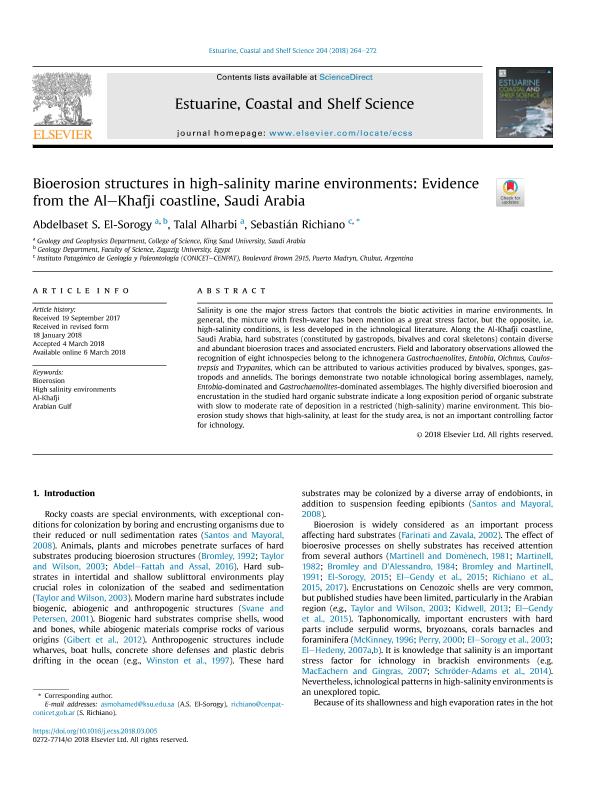Artículo
Bioerosion structures in high-salinity marine environments: Evidence from the Al–Khafji coastline, Saudi Arabia
Fecha de publicación:
05/2018
Editorial:
Academic Press Ltd - Elsevier Science Ltd
Revista:
Estuarine, Coastal and Shelf Science
ISSN:
0272-7714
Idioma:
Inglés
Tipo de recurso:
Artículo publicado
Clasificación temática:
Resumen
Salinity is one the major stress factors that controls the biotic activities in marine environments. In general, the mixture with fresh-water has been mention as a great stress factor, but the opposite, i.e. high-salinity conditions, is less developed in the ichnological literature. Along the Al-Khafji coastline, Saudi Arabia, hard substrates (constituted by gastropods, bivalves and coral skeletons) contain diverse and abundant bioerosion traces and associated encrusters. Field and laboratory observations allowed the recognition of eight ichnospecies belong to the ichnogenera Gastrochaenolites, Entobia, Oichnus, Caulostrepsis and Trypanites, which can be attributed to various activities produced by bivalves, sponges, gastropods and annelids. The borings demonstrate two notable ichnological boring assemblages, namely, Entobia-dominated and Gastrochaenolites-dominated assemblages. The highly diversified bioerosion and encrustation in the studied hard organic substrate indicate a long exposition period of organic substrate with slow to moderate rate of deposition in a restricted (high-salinity) marine environment. This bioerosion study shows that high-salinity, at least for the study area, is not an important controlling factor for ichnology.
Palabras clave:
AL-KHAFJI
,
ARABIAN GULF
,
BIOEROSION
,
HIGH SALINITY ENVIRONMENTS
Archivos asociados
Licencia
Identificadores
Colecciones
Articulos(IPGP)
Articulos de INSTITUTO PATAGONICO DE GEOLOGIA Y PALEONTOLOGIA
Articulos de INSTITUTO PATAGONICO DE GEOLOGIA Y PALEONTOLOGIA
Citación
El Sorogy, Abdelbaset S.; Alharbi, Talal; Richiano, Sebastián Miguel; Bioerosion structures in high-salinity marine environments: Evidence from the Al–Khafji coastline, Saudi Arabia; Academic Press Ltd - Elsevier Science Ltd; Estuarine, Coastal and Shelf Science; 204; 5-2018; 264-272
Compartir
Altmétricas




